History of Epiphone guitars: secrets, myths and truths
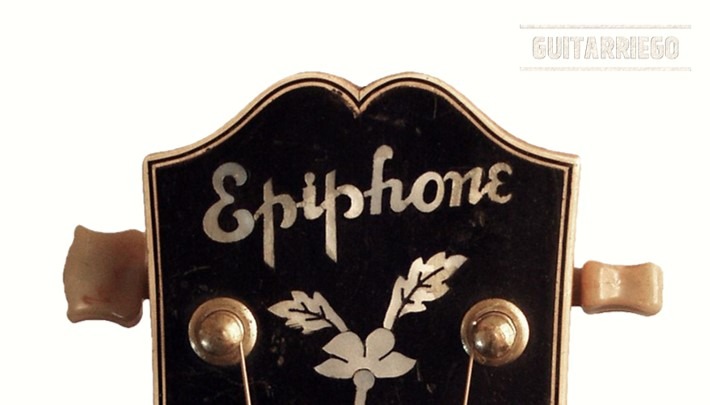
Epiphone is one of the guitar manufacturers in the United States with more history and tradition, contemporary and direct rival of Gibson for decades, behind this century-old brand there are secrets, myths and truths.
Brief introduction to the history of Epiphone
The history of Epiphone guitars begins with a Greek family, the Stathopoulo, who in 1879 were based in Turkey and then, in search of the American dream, emigrated to the United States in the early 1900s. A common brand to find during the decades of 20s and 30s in nightclubs, recording studios and radio broadcasts. Epiphone is synonymous with tradition, craftsmanship, quality and innovation in musical instruments, not just guitars, but mandolins, basses and other musical instruments as well.
Stathopoulo House
Seventy years ago, the “Stathopoulo House” as Epi’s Manhattan showroom was known, was a gathering place for the best musicians in the Big Apple.
Musicians who used Epiphone
Epiphone was one of the biggest brands in the early acoustic and electric guitar years in America. Along with Gibson, they were the most recognized and coveted brands of guitars. The variety of musicians that traverse the history of Epiphone is remarkable and extensive. Jazz greats like George Van Eps, country pioneers like Hank Garland, blues musician John Lee Hooker, the Liverpool boys: John Lennon, Paul McCartney and George Harrison, and even Les Paul himself, just to name a few were users. of this century-old brand.
Epiphone Casino and the Beatles
Beatles bassist extraordinaire Paul McCartney chose an Epiphone Casino as his first American-made guitar and was quickly followed by John Lennon and George Harrison. The Casino was featured on every Beatles album from Help to Abbey Road.
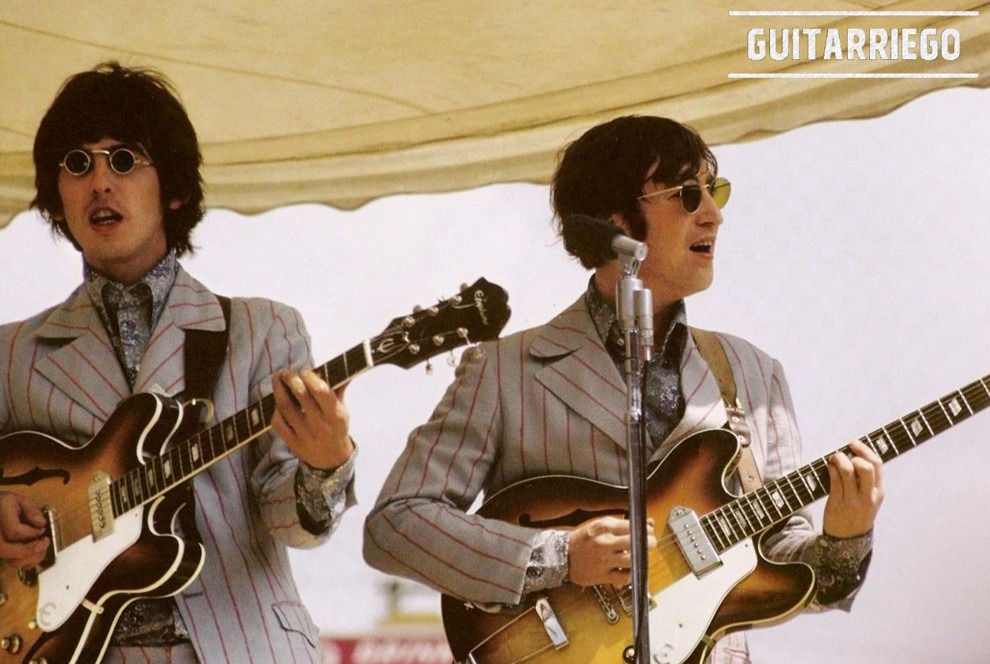
Epiphone and Les Paul
“Epiphone always made a good guitar” Les Paul once said. And that, after all, is what all musicians are looking for. Les Paul, always shared his love between Gibson and Epiphone.
The beginnings of the Stathopoulo in luthería
The opening chapter of Epiphone’s history begins in the mid-1870s, when the Greek Stathopoulo family settled in Izmir, a Turkish city with a strong Greek presence. There they had a shop where they sold and repaired lutes, violins and bouzoukis. The latter is a Greek stringed instrument similar in appearance to the mandolin.
By 1890, Anastasio Stathopoulo had already earned a reputation as a luthier and opened his own instrument factory. A few years later, Anastasio married and started a family. Their first child, Epaminondas, was born in 1893, followed by Alex, Minnie, Orpheu, Frixo, and Ellie. Epaminondas would later play a key role in the history of Epiphone guitars.
The Stathopoulo American Dream
Years later, in the early 1900s, the Stathopoulo family moved to the United States and settled in Manhattan. Once in America, Anastasios continued his trade in musical instruments. On March 25, 1909, Anastasios filed his first and only patent for an Italian-style mandolin. Here, we see the first similarities to Gibson’s origins, since the first relevant step in Gibson’s history was the patenting of a novel mandolin, although Orville did it a decade earlier.
Epi Stathopoulo, the great creator
Epi, as Epaminondas, Stathopoulo’s eldest son, was known, adapted easily to American life. He attended Columbia University and graduated with honors.
With Anastasios, his father, making and selling his instruments downstairs and Epi along with his entire family living upstairs in the same building, the line between work and family life became increasingly blurred. Thus, Epi and Orpheus (‘Orphie’) soon became involved in the family business, which was located at 247 West 42nd Street.
Death of Anastasios: Epi takes control
Epi was only 22 when her father Anastasios died. As the eldest son, Epi had the responsibility of keeping the business going. Being a scholar and enthusiast of his father’s work, in order to position himself in the market, he replaced his father’s name on the labels: “A. Stathopoulo” for that of: “The house of Stathopoulo, quality instruments since 1873”. Also, it eliminated most of the old-style mandolins, while also introducing the Recording line of banjos, then the most popular instrument in the United States.
Business expansion, «Epiphone» appears
Epi continued to expand the business and also its reputation for quality work. The Stathopoulo family acquired the goodwill and modern machinery from an instrument plant from the Farovan Company on Long Island. Here, Epi changes the name of the burgeoning company, thus the name by which the company is known worldwide today was born: Epiphone.

Why the name Epiphone?
Epiphone is a play on words, according to the company’s own page, it is on the one hand the nickname of Epaminondas, Epi, and on the other the word phon Greek word that means “sound” and “voice”.
Business development focused on banjos
Epi became chairman and CEO and announced his focus on banjos: “the new business policy and all interest will be devoted to the production of banjos, tenor banjos, banjo mandolins, banjo guitars and banjo ukuleles under the name registration commercial for ‘Epiphone’ ». The most popular instrument in North America at the time.
Epi retained most of the skilled workers at the Long Island factory. Production increased and quality improved. Ornate banjo models were introduced in 1927, with models such as the Emperor ($ 500), the Dansant ($ 450), the Concert Special ($ 300), and the Alhambra ($ 200). Business was doing well and the Stathopoulo brothers, with Orphie now as vice president, moved the company to 235-237 West 47th Street.
By 1928, The Epiphone Banjo Company was making banjos for Selmer / Conn and the Continental Music line of stores, a major instrument distributor.
The first guitars and the beginning of the rivalry with Gibson
In 1928, Epiphone introduced its first line of acoustic guitars to compete with the company that Epi determined was the greatest rival, Gibson.
Epiphone Recording Series Guitars
The Epiphone Recording Series of acoustic guitars, like the banjo line, were identified by a letter, from ‘A’ to ‘E’, and were distinguished by their unusual body shape. The instruments combined spruce and laminated maple and were available with flat and arched tops.
Recording guitars were unsuccessful. One problem was a lack of endorsement from famous artists, the other was a lack of size. These acoustic guitar models were too small, especially compared to the size and volume of the popular Gibson L-5, which was introduced in 1922 and had quickly become an industry standard.
Although banjo sales were stable, in the immediate aftermath of the stock market crash of 1929, Epi was well aware that archtop guitars were becoming more popular and that their main competitor in quality and design was Gibson.
Epiphone Masterbilt Series Guitars
In 1931, the Epiphone Banjo Company announced the introduction of the Masterbilt line of guitars with a carved-archtop- top and two f-holes. It was not difficult to see the influence of the L-5 on the new line. Epi’s guitars had similar f-holes, pegheads, and even a name similar to the Gibson Master Model range. Epi continued to distinguish his company with model names that musicians could easily remember and be proud to own.
The Epiphone Masterbilt line included the De Luxe ($ 275), the Broadway ($ 175) and the Triumph ($ 125). The De Luxe, according to the advertisements, featured a ‘carved spruce top, flamed curly maple back, violin construction on all parts, big f-holes, borders -binding- in black and white and a sweet and resonant tone.

The war with Gibson: size does matter
Throughout the 1930s, the rivalry between Epiphone and Gibson turned from friendly combat to all-out guitar warfare. Gibson responded to the Masterbilt with a new archtop design in 1934, increasing the body width of its existing models and introducing the king-sized Gibson Super 400, named for its $ 400 price tag.
Not to be left behind, Epi responded the following year with the Emperor, its top-of-the-line model. This new model had an even wider body and a provocative ad campaign with a naked woman holding the Epiphone archtop. In 1936, Epiphone struck again, increasing the size of the De Luxe, Broadway, and Triumph guitars by an inch. These models were wider than Gibson archtops by 3/8 ″ and one of the most distinctive instruments on the market.

Epiphone’s early golden age
In the mid-1930s, Epiphone guitars were considered to be among the best in the world, and Epi himself enjoyed the patronage of the scene’s most respected musicians. Epiphone went intercontinental with a distribution agreement with Handcraft Ltd. of London.
In addition, the company opened a new showroom at 142 West 14th Street in a seven-story beaux-arts building near Little Italy. The new building included a research and development laboratory advertised as ‘state of the art’. The Epiphone showroom on the first floor was both the company headquarters and a gathering place for musicians. On Saturday afternoons, Epi would open shop windows and let the leading guitarists of the time – artists like Al Caiola, Harry Volpe and Les Paul – perform while people listened on the sidewalk.

Epiphone Growth and Diversification
Steel or Lap Guitar Electar Series
Epi was also aware of the success of the Rickenbacker steel electric guitar models. In 1935, Epi made his move with the introduction of the Electar series, originally known as Electraphone, from Steel Guitar. Epi’s unique design features include individually adjustable pole pieces on the Master Pickup. The Electar line furthered Epiphone’s reputation as an innovative brand.

Electric piano
By the end of the 1930s, sales had doubled. Collaborations between Epi and other companies became more frequent. In July 1936, Epiphone showed several new models at the National Association of Music Dealers (NAMM) show at the Stevens Hotel in Chicago, including an electric piano created with the Meissner Inventions Company in Milburn, New Jersey.
Incursion into amplifiers
Epiphone also began selling amps after meeting electronics enthusiast Nat Daniel, a friend of Les Paul. Daniel perfected an innovative push / pull cabling design, which is now an accessory on many amplifiers. Epiphone reps listened to Daniel’s amps and hired him to build chassis and new designs. Years later, in the 50’s, Daniel would start the Danelectro line of guitars and amplifiers in the 50’s.

Hawaiian guitars
In the late 1930s, just prior to America’s entry into World War II, the rivalry between Epiphone and Gibson showed little sign of abating. In 1939, the two firms introduced similar pitch-changing Hawaiian guitar designs, the predecessor of pedal steel.
When Gibson introduced a violin line, Epiphone responded with a vertical bass line. It took the outbreak of World War II, a shortage of key materials, and the virtual shutdown of guitar production around the world to give the escalation between the two manufacturers a respite.
Epiphone decline
Epi Stathopoulo’s passing
Epiphone was one of the preferred brands on the market, an industry leader. But at the end of the Second World War in 1945, it had suffered a great blow; the Company had lost its leader when Epi died of leukemia. Shares and control of Epiphone went to younger brothers Orphie and Frixo.
Epiphone continued to compete aggressively with Gibson, each introducing versions of their best cutaway archtop electric guitars. The pickups also continued to be refined and musicians continued to appear on stage with Epiphone guitars.
From the outside it seemed that everything was going as usual. But soon cracks appeared both on the production line and in the meeting room. The Stathopoulo brothers did not agree with the vision of the future of the company, and in 1948 Frixo sold his shares to Orphie.
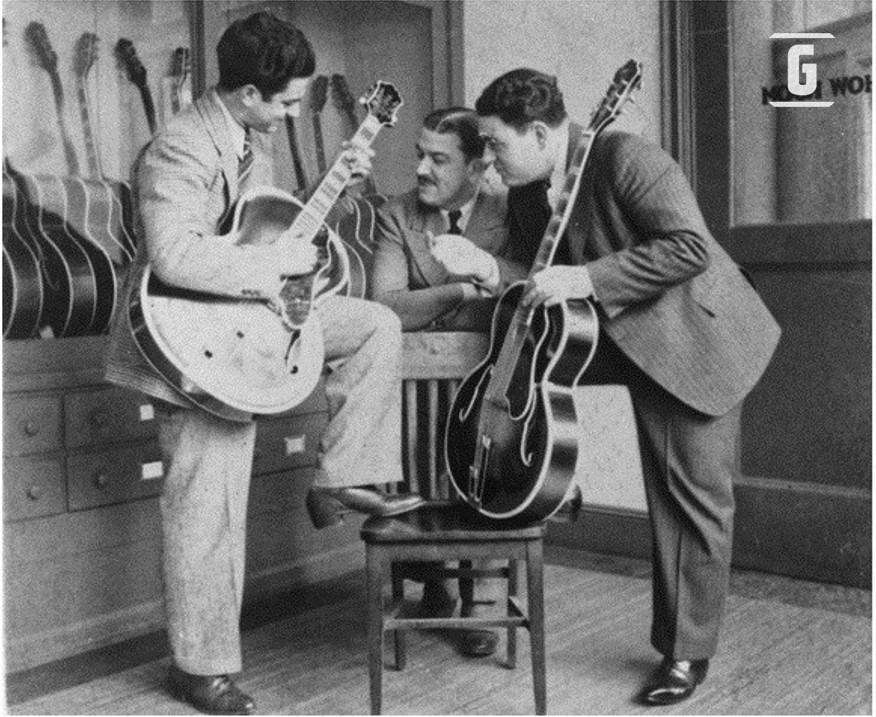
The company’s reputation for craftsmanship and innovation that Epi had built in the 1920s and 1930s did not survive the postwar years. Tastes were changing and Epiphone products seemed traditional and somewhat dated.
In 1953, the Epiphone factory moved from Manhattan to Philadelphia to avoid a union clash, but many of the company’s craftsmen refused to leave New York, and the company lost qualified personnel, further weakening its situation.
Epiphone and Les Paul
Les Paul, was a lover of Epiphone and Gibson guitars. I had contact with both companies. In fact, he had access to the Epiphone plant, where the artist experimented with instruments and in 1940 built his solid guitar called The Log. With this guitar he went to Gibson to propose the solid guitar project, but the then president, Maurice H. Berlin, rejected it, calling the instrument “broom”. It is not clear if he also did the same with Orphie.
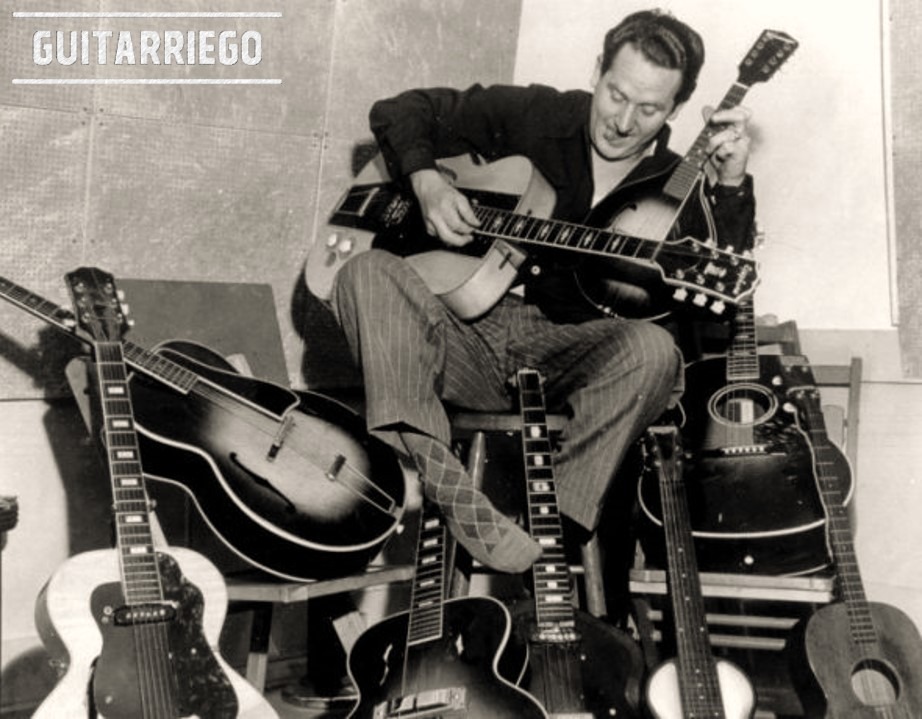
Les Paul used Epiphone guitars on stage until Gibson’s new chairman Ted McCarty years later offered to name the brand’s first solid-body guitar after him, the Gibson Les Paul.
Gibson buys Epiphone in 1957
As Epiphone waned and the crisis was already apparent, Les Paul suggested to McCarty that Gibson approach Epiphone. McCarty followed the advice and reached out to Orphie, expressing Gibson’s interest in Epiphone’s critically acclaimed upright bass division, which Gibson had not produced again after WWII. When Orphie responded in 1957, he offered McCarty the entire Epiphone company, including the remaining inventory from the Philadelphia factory, for just $ 20,000; McCarty accepted on Gibson’s behalf. Thus, the Stathopoulo family was out of the instrument business, and a new era was beginning for Epiphone.
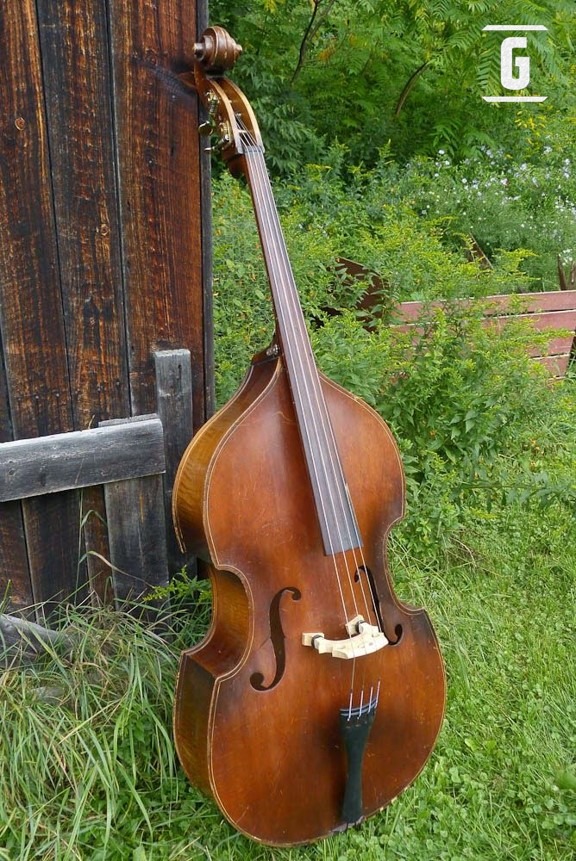
Although McCarty’s original intention was to bring the Epiphone bass models to the Gibson catalog and take advantage of the machinery of its long-time competitor, he soon changed his mind. Ultimately, McCarty would revive the Epiphone brand with a new line of instruments.
Gibson makes Epiphone instruments
McCarty’s original plan was to offer to add Epiphone upright basses to the Gibson product line. However, since Gibson worked with exclusive distributors and dealers by zone, there were important stores and businesses to which they could not sell because they were in an area that already belonged to another official agent. Thus, they decided to market the Epiphone brand to work with those important commercial channels to which Gibson could not sell. Thus, dealers obtained a quality Gibson product without conflict with those who had the exclusivity of the Gibson line.
The entire Epiphone operation was relocated to Kalamazoo, Michigan. Epiphone was back in business, better than ever.
Gibson guitars with Epiphone branding
So it was that Gibson made instruments under the Epiphone brand for more than a decade. In this way, you can find Epiphone instruments from the late 50’s and 60’s that are actually Gibson guitars that were built in the same Kalamazoo factory.
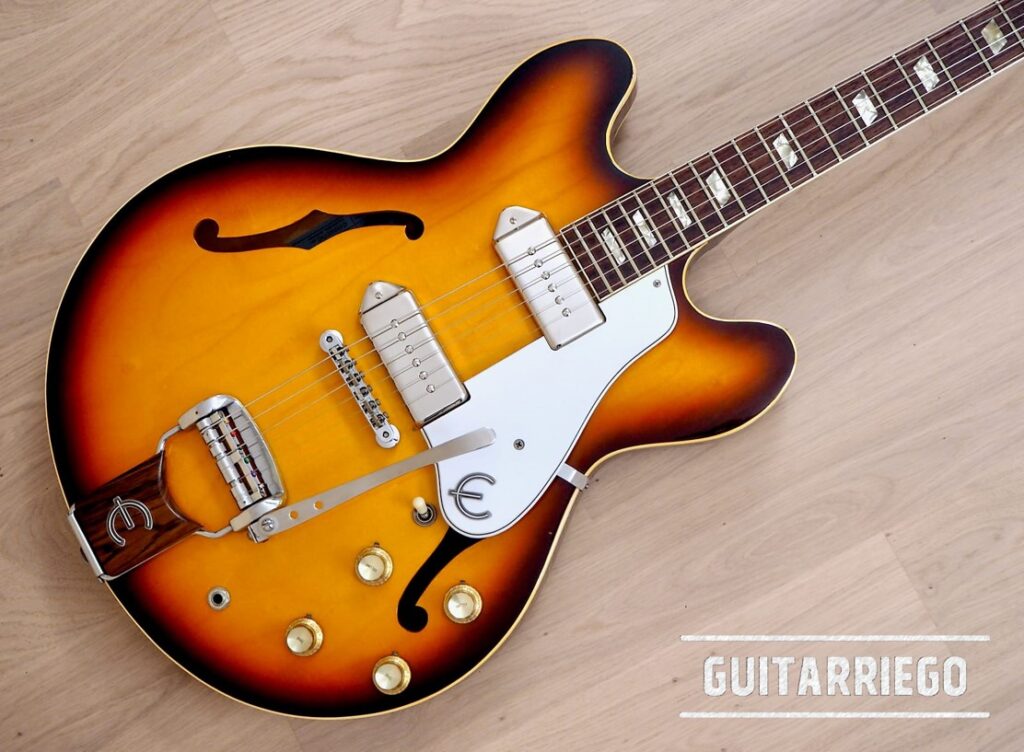
New Epiphone Profile
When Epiphone instruments were first distributed in 1958, the brand had three well identifiable lines. For one thing, Epiphone now had cheaper versions of the existing Gibson models; Also included were reissues of the brand’s classic designs, such as Emperor, Deluxe and Triumph; and finally, the brand was rounded off with new designs such as the semi-hollow Sheraton, the solid-body Moderne Black and the Frontier flat-top acoustic, whose square-shouldered body style was the first built at the Gibson Kalamazoo factory.
In addition to the guitar lines, a new line of amplifiers was launched. This shows that while it was an accessory brand to Gibson, it also had some independence, at least from a product perspective.
Market welcome to the new Epiphones
The grand presentation of the Epiphone line took place at the NAMM trade show in July 1958 with the electric Emperor as the flagship model. The show itself would generate orders for 226 guitars and 63 amps, a modest return. Over the next several years, Epiphone would sell 3,798 instruments in 1961 and in 1965 it would represent 20% of the total instruments shipped from Kalamazoo. Even more impressive was the prestige of the guitars themselves. In the early 1960s, the Epiphone Emperor cost significantly more than the top-end Gibson Byrdland, while the 1963 Deluxe Flattop Excellente cost $ 100 more than the Gibson J-200 and was made from tonewoods more rare.

Epiphone and folk music
Folk music was booming in the United States in the early 1960s, and Epiphone found the perfect profile and guitar offering for that style of musician. Epiphopne launched the Seville classical guitar in 1961, with and without pickups, they also presented other models such as the Madrid, Spain and Entrada models, Epiphone became a benchmark of the musical style.
Epi, Pop and Rock ‘n Roll
In 1962, Epiphone included a twelve-string instrument, the Bard guitar, with which Roy Orbison composed “Oh, Pretty Woman” and “Only The Lonely,” along with a smaller version, the Serenader. In 1963, the Troubadour, a flat-top steel-string guitar, was introduced.
Epiphone’s acoustic range was accompanied by the line of electric guitars. The most famous of these was the Double Cut Casino, first introduced in 1961. When the Beatles appeared playing with Epiphone Casinos around 1966, they probably marked the best moment for the brand, showing a very promising future.
A winning instrument catalog
Epiphone had a catalog of fourteen archtop electric guitars, six solid body electric guitars, three basses, seven flattop acoustic guitars, six classical archtops, four acoustic archtops, three banjos, and a mandolin.
The early to mid-1960s was a boom time for Epiphone, with unit sales increasing fivefold between 1961 and 1965.

The late 60s, a challenging market
Epiphone was at its peak in the middle of the decade, with great recognition from the most famous artists. However, the growth of copies made abroad were stealing the market from instruments made in the United States that were much more expensive. Thus, at the end of the 1960s, these cheap copies gained more than 40% of the market share of Epiphone, Gibson and other American companies, some even ended up melting.
Change of owners and strategy
However, the crisis was not limited to the “invasion” of cheap foreign products, there were also internal problems. In Gibson, a new shareholder was entering, with whom Ted McCarty, president of Gibson – and Epiphone -, did not have a good relationship. In 1965, Ted receives an offer from Paul Bigsby, with whom he had a friendship. Paul was retiring and wanted someone he trusted and esteemed to continue his company. So he offers the company and Ted accepts, which meant his departure from Gibson months later.
Gibson’s parent company, CMI -Chicago Musical Instruments-, was bought -at least in part- in 1969 by ECL -Ecuadorian Company Limited-, an Ecuadorian brewing company. The two companies merged in July of that year, resulting in Norlin Corporation. Thus beginning the obscure “Norlin era of Gibson.”
Norlin is the combination of the names of the top men from both companies, Norton Stevens from ECL and Arnold Berlin from CMI. They were both friends and had been classmates at Harvard Business School.
At this time, is where the situation of Epiphone radically changes. The brand was perceived as inferior to Gibson by the new management of the company; and so it was treated, although it could not sell instruments cheap enough to compete with inferior foreign imitations.
Epiphone moves to Japan
Before the sale to ECL, the possibility of producing the Epiphone product in Japan had already been considered. The Japanese country had a good industry of musical instruments and low costs. Thus, in 1970, Epiphone production in the United States was closed and it moved to Matsumoto, Japan. However, during the first years of production, the Epiphone guitars made in Japan were designs already produced by the Matsumoku Company, with only the Epiphone branding on the headstock.
Starting in 1976, the models gradually improved. During those years, Epiphone introduced several instruments: The Monticello and Presentation acoustic guitars; a series of electric guitars with a scroll body; a new range of flat tops and the Nova series of acoustics along with the Genesis solid body line. By 1979, the Epiphone product list was expanding, with more than 20 guitars. Epi was being re-founded.
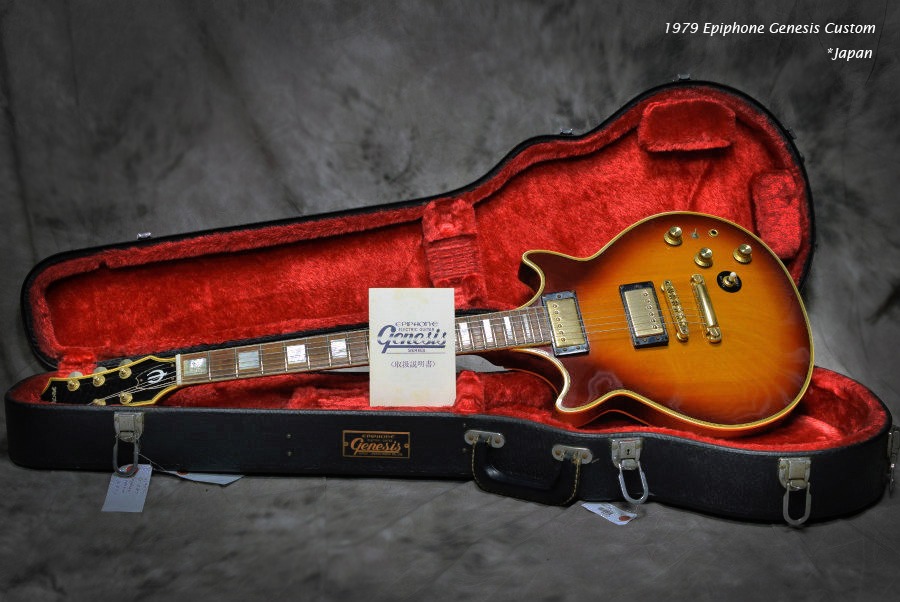
Epiphone Korea
In 1983, with the Japanese cost rising as a result of the revaluation of the Yen, Epiphone’s production moved to Korea. There, the guitars were built by the Samick Company. In this way, Epiphone definitely became the brand of budget guitars that we know today.
Epiphone resurgence
In 1986, Henry Juszkiewicz, David Berryman, and Gary Zebrowski purchased Gibson and Epiphone from ECL / Norlin. His first goal was to revive Gibson, and Epiphone, which had a turnover of less than $ 1 million in 1985, was shelved. However, new shareholders quickly saw the potential of the more than 100-year-old company.
Juszkiewicz and Berryman regarded Epiphone as a sleeping giant. Thus, they traveled to Korea to decide how the company could be encouraged to match the success of other Asian brands such as Charvel and Kramer. Epiphone models were revived and new production techniques began to pay off. Soon, sales grew again.
In 1988, Epiphone included a new PR series of square-shouldered acoustics along with a version of the Gibson J-180, various classical guitars, a banjo, and a mandolin. There was also a clever selection of original Gibson models like the Les Paul and SG, new archtops like the Howard Roberts Fusio, and the rebirth of the Sheraton.
Epiphone and the 90’s
By the 1990s, Epiphone already offered 43 different models in a variety of styles and budgets. Gibson President David Berryman opened an Epiphone office in Seoul and appointed Jim Rosenberg as product manager, and set out to make Epiphone an innovative guitar maker again.
The creation of an office in Seoul proved to be a major turning point for the new Epiphone, as engineers and luthiers collaborated to remake the company. Factory processes were evaluated and refined; and Epiphone’s own engineers were actively involved in the development of pickups, bridges, selector switches and fret inlays, as well as unique features such as the metallic ‘E’ logo and ‘frequensator’ tailpiece. Epiphone invested in new models and the market responded well.
At the time of the 1993 NAMM show, a new range of electric and acoustic instruments debuted to rave reviews and customer response.
Epiphone Made in USA reissues

In 1993, a limited series of Riviera and Sheraton guitars were produced at the Gibson factory in Nashville. Also, the Montana plant built 250 Excellente, Texan and Frontier guitars. These Epiphone guitars were only intended as a special event, but public reaction prompted Rosenberg to reissue more classic designs.
Those who attended the 1994 NAMM witnessed the reintroduction of Epiphone legends such as the Casino, Riviera, Sorrento and Lower Rivoli.
Artists Epiphone Guitars
In the months that followed, a diverse range of artists, from Chet Atkins to Noel Gallagher of Oasis, were invited to join Epiphone. The message was clear: “Epiphone is still a great instrument company.”
Arguably, Epiphone was as successful in the late 1990s as at any other time in its history. The Advanced Jumbo series and several major Signature models were released, including John Lee Hooker’s Sheraton and Noel Gallagher’s Supernova. The Epiphone Casino John Lennon 1965 and the Revolution meant a return to authenticity and self-identity. In addition, associated with one of the best artists of all time, which highlighted the resurgence of the company itself as a music legend.

Epiphone in the 21st century
In 2000, Epiphone introduced the Elitist range, made in Japan, and strengthened its position in the acoustic market with the acquisition of longtime Gibson luthier Mike Voltz. Voltz contributed to the re-development of Epiphone with the reintroduction of the Masterbilt range along with the 2005 reissue of the Epiphone Paul McCartney 1964 USA Texan.
International demand for Epiphone grew so high that the company opened a new factory in China in 2004, the first time Epiphone had returned to its own factory since its purchase by Gibson in 1957.
Epiphone News
Today, Epiphone offers a wide range of guitars. Within the range of guitars, Epiphone has in its catalog with acoustic instruments reissues of classic models, Hollow-body and Semi Hollow-body and solid body electrics both original Epiphone, such as Wilshire Phant-o-matic, Genesis, DC Pro, Casino, and others, as well as classic Gibson models, including the Les Paul, SG, Flying V, and Firebird.
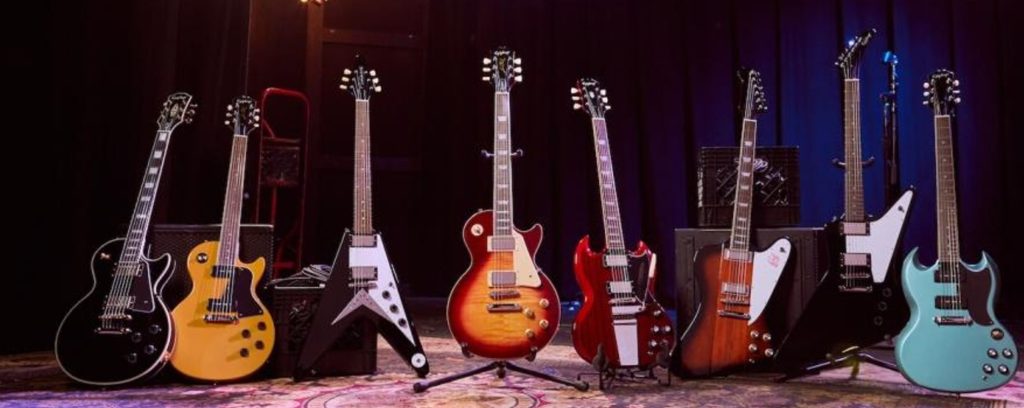
Thus it offers options for guitarists of all genres and of varied budgets. Working musicians value Epiphone for its inexpensive versions of Gibson’s classical guitars or original models from the century-old brand founded by the Stathopoulo family. But also guitar collectors look for the old and iconic Epiphones acoustic and Hollow-body such as the Emperor, Casino, Excellente, among others.
Today Epiphone is based in Nashville, very close to Gibson’s. From there he manufactures guitars in his tradition of affordable quality standards and innovation. Thus, while Epiphone today specializes in cheap guitars, it has quality guitars that rival those of virtually any manufacturer in the world.
Additionally, Epiphone today features guitars from artists like the Marcus Henderson, the Zakk Wylde ZV Custom, and the Joe Bonamassa Goldtop. Thus, Epiphone is a brand with much more history than the ordinary guitarist knows. Having a unique tradition and track record, only comparable to Gibson’s.
More information go to Epiphone.com
Related Articles: Epiphone vs Gibson Les Paul.


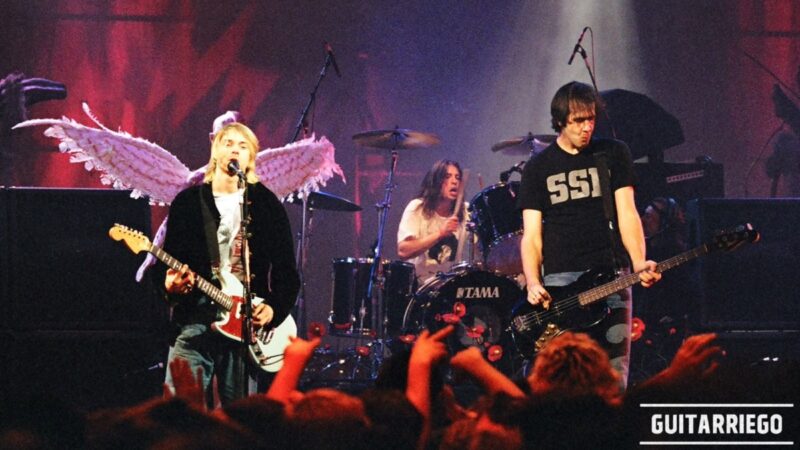




One of best guitar stories I’ve read in a long time. Would really enjoy reading more stories and the knowledge of the epiphone guitar. With myself owning a SG P90 WORREN PHALEM BLUE FINISH and is very well crafted guitar. Thanks for sharing your knowledge with us. Kenny Barnhart
I purchased I think it’s a 62 with those beautiful dog ear pick ups and a Bigsby whammy bar!The label inside is just like the Kalamazoo one that Gibson hard when it had the Kalamazoo factory!
I just bought an epi wildkat w bigsby tremolo i let you know how it turns out